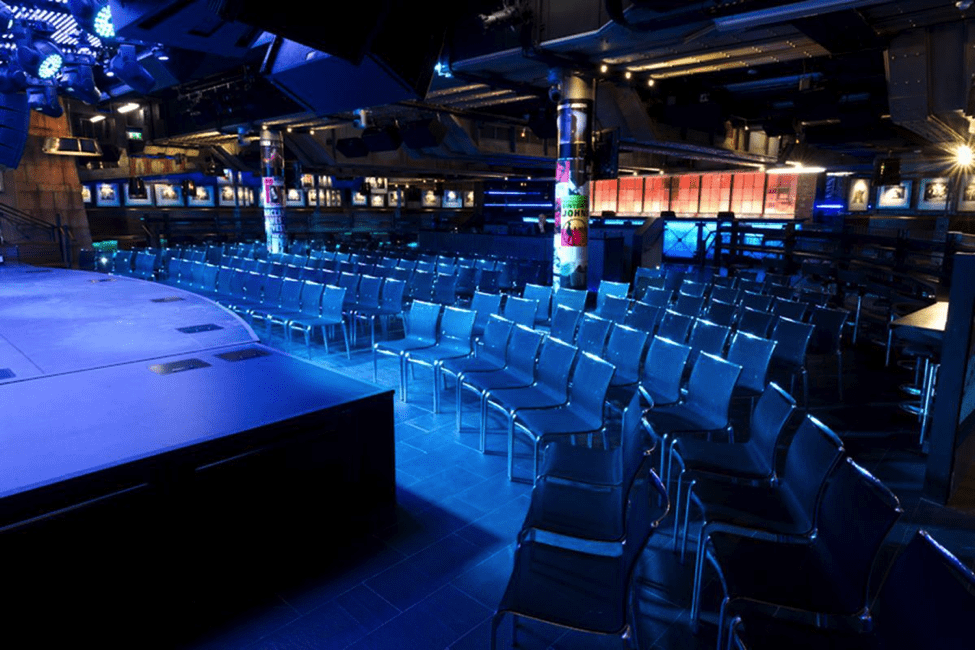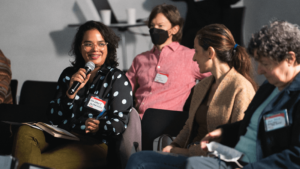Over the last few years, health and safety for events has been at the forefront of creators’ minds. Finding ways to look after your guests and adhering to regulations are essential parts of your planning list.
As an organiser, you’ll want to ensure the safety of attendees and staff. That means taking reasonable steps to prevent harm from coming to anyone involved in your event and planning for emergencies. The larger your event, the more challenging this can be. That said, risk assessment for smaller community events is equally important; safety always comes first.
To help you along your health and safety journey, here are the main aspects to consider when event planning. Your final safety checklist will be more extensive, but this is a great place to start. Remember to stay on top of government guidance and reach out to local officials if you’re unsure.
Assess the suitability of your venue

Start with a written profile of your event, including all the activities that will take place and the estimated audience size and demographics (i.e. children, the elderly, or disabled people will have different needs). With this in mind, visit your event venue before booking to assess its suitability.
Factors to consider include:
- Capacity: Can your attendees be safely accommodated inside the venue? Will guests be standing or seated? Is there room to circulate? Are there pinch points where overcrowding could occur?
- Access: Is there sufficient access to the event site/venue for pedestrians and vehicles? Are people with disabilities, wheelchairs, or prams able to access the venue? Are there enough emergency exits?
- Hazards: Are there existing hazards, such as overhead electric power lines or buried services your structures could interfere with? Is the site prone to flooding or high winds? Consider ground conditions and topography when positioning temporary structures.
- Facilities: How far away are the nearest hospital and fire station? What are the public transport links like? Consider the infrastructure you need for your event.
Once you’ve confirmed the suitability of your venue for an inclusive event, draft a site plan indicating where the structures, facilities, fencing lines, entrances, and exits will be. Make the plan available to all contractors, suppliers, and staff working on the event.
Do a risk assessment with an event health and safety checklist

Event risk assessment is easier with a health and safety checklist. It lets you think about potential risks to safety at your event and rate them. A scale from one to five can be helpful, with one presenting a negligible risk and five presenting a severe risk.
Hazards to consider include:
- Trip or equipment hazards: Are there cables or guy ropes that people could trip over? Is there glass that people could bump into? Could people come into contact with generators or other electrical equipment?
- Crowd management hazards: Could crushing or overcrowding occur? How can you handle aggressive or drunken behaviour? Are people at risk around roads or car parks?
- Crew hazards: How will you protect those working for you from lifting and carrying injuries? If you invest in lifting equipment, take a look at Model Code of Practice: Hazardous manual tasks.
- First aid hazards: Could people injure themselves through activities? If so, what injuries could occur? Could runners suffer heat exhaustion in high temperatures? What would happen if an attendee suffered a heart attack?
- Weather hazards: Could the ground become slippery when wet? Could the wind threaten the stability of structures? Could equipment get wet or become overheated?
- Environmental hazards: Could event activities damage the venue or site? Could rubbish threaten wildlife? Could contamination occur from spillages?
- Fire hazards: How will you control smoking in the venue or onsite? Could campers use barbecues or stoves? Could an electrical fire occur? Are there fire extinguishers?
- Catering hazards: Could ovens or hot water urns cause a risk? How will food allergies be handled? Are the containers for hot food and drink suitable?
- Terrorism and security: Can you implement bag checks to prevent security threats? How can you ensure only ticket-holders can enter?
- Child protection hazards: Is there a risk of children becoming lost? Could there be allegations of abuse or neglect? Do staff need to a Working with Children Check?
- COVID-related hazards: How many people are attending? Is the venue big enough to prevent overcrowding? Are there sufficient handwashing facilities and sanitation stations?
Write down all possible risks to event safety and who could be affected – attendees, crew, members of the public, or the venue itself – and how you will mitigate and manage each risk. Place extra focus on your most severe risks and prioritise them to reduce the risk to an acceptable level.
Collaborate with your team for the risk assessment; they may notice things that aren’t obvious to you. It’s also helpful to work closely with your suppliers on safety management for events. Asking to see risk assessments and method statements from caterers, marquee providers, and AV companies can help you mitigate risk together. Where appropriate, involve the local authority and emergency services. For more guidance on creating and completing risk assessments, visit the Safe Work Australia website.
Create an emergency event plan

It’s essential to plan for situations requiring urgent action, from a fire to a stage collapsing or terrorist incident. Even bad weather can create an emergency.
To feel prepared, develop emergency procedures to be followed by anyone working on the event and discuss your plans with the venue management. For larger events and/or those not in a fixed venue, include police, fire and rescue service, and the ambulance service in your consultation.
Aspects to consider when developing procedures include:
- Raising the alarm: How will you communicate the emergency with staff and volunteers?
- Informing the public: Do you have an adequate public address system? What’s the procedure for stopping (and restarting) the show?
- Onsite emergency response: Are there fire extinguishers and clear emergency procedures in the event of a fire? Do you need security staff?
- Summoning and liaising with the emergency services: Who will be your point of contact, and how will you assist the emergency services?
- Crowd management, including evacuation: How will you move people away from immediate danger to a place of safety? Consider people with limited mobility and children.
- Traffic management: How will emergency vehicles access the site? How will vehicles leave the site in the event of an emergency?
- Providing first aid: Are there sufficient medical provisions?
- Handling casualties: How will patients be taken to a hospital? Will there be ambulances onsite?
- Security: How will you raise the alarm if there’s a threat?
According to the Safe Work Australia, testing and validation of your emergency plan can take the form of a tabletop exercise. Think about setting up a meeting with your appointed team members to work through a range of scenarios and establish the effectiveness of your responses. Get them to find answers to real-life issues, such as how to manage overcrowding, and then discuss why we use barriers.
Implementing health and safety requirements for an event
Implementing health and safety measures will help you manage staff, suppliers, and attendees and ensure they aren’t exposed to risk, from set-up to breakdown.
To keep everyone on the same page, provide staff with relevant information during the site induction and ensure suppliers do the same for their employees. Include information such as site hazards, speed limits and parking, first aid, toilets and wash facilities, and emergency arrangements. Provide relevant health and safety information to the public through signage and/or a pre-event announcement.
To monitor risks throughout your event, create a checklist and have a nominated individual/s responsible for checking at regular intervals. A clear and competently implemented paper trail is the best way for event organisers to mitigate risk.
Crowd safety at events

Live events come in all shapes and sizes, from intimate get-togethers to festivals, conferences, concerts or attractions. While any event presents health and safety challenges, the scale of your event directly influences potential risks. The bigger the crowd, the higher the impact on crowd safety.
One potentially dangerous threat at a big event is a crowd surge. Crowd surges work like a wave; the danger is that people get swept along beyond their control. Once they start, they can be hard to stop. Be vigilant and know how to prevent crowd crush by taking the correct precautions – managing crowd build-up or halting the event.
How to prevent crowd surge
Preventing crowds from surging forward involves careful planning and thorough risk assessment. People move when things change. That could be a headline act coming on, a gig starting, or even a downpour of rain. Whatever the reason, the crowd suddenly reacts, and the more people there, the greater the effect.
Steps to take in preventing crowd surges include:
- Entrances and exits: Do you have enough security personnel for the size of the crowd? Are entrance and exit points signposted? Do staff have a separate entrance? Are there sufficient access points for emergency services? Are all emergency exits clear and unlocked?
- Separating crowds: Do you have event barriers to prevent people from being in one place? Will they be strong enough to prevent surges? Are standing-room-only areas sectioned off? Are there walkways between for security staff to use?
- Security staff: Do you have enough security staff? Can they easily access all areas of the event? Are they trained to deal with large crowds? Who manages security staff at your event?
- Crowd spotters: Do you have people positioned to identify crush points and crowd build-up? Where will they have the best vantage points? How will you alert event performers of a potential threat?
- Emergency planning: In an emergency, do you have a protocol to halt the event? How will you communicate with the crowd? Who has overall responsibility for managing an emergency at your event? Do you have enough trained first-aiders and first-aid kits on site?
Ensuring your staff are on board and know what trigger points to look out for helps keep everyone safe.
Resources for creating safe events
The event safety tips above aren’t exhaustive, but they’ll help kickstart your health and safety planning. For more information on risk assessment and management, look at the guides on the Safe Work Australia website. And remember: it’s vital to stay up to date and comply with the latest government guidance before hosting any live event.
Identifying and understanding how to implement health and safety measures is vital to event planning. As a responsible event creator, you must find solutions to potential hazards. Our templates and platform help you pinpoint and manage various risks – meaning staff and attendees stay safe as they enjoy your event.






